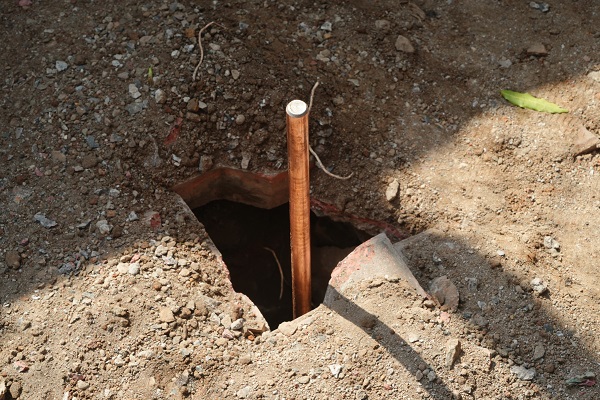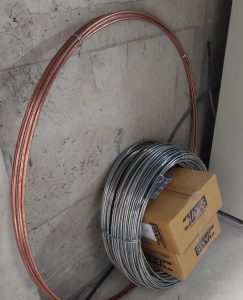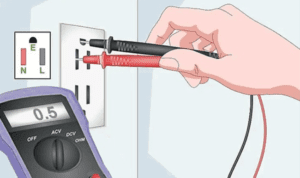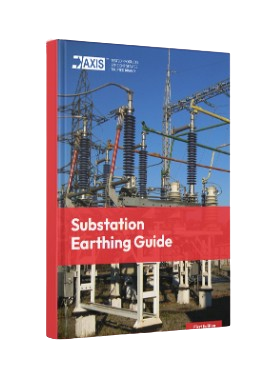Good earthing systems play a critical role in protecting structures, equipment, and personnel from the devastating effects of lightning strikes. With fast rise times and large magnitude currents associated with lightning, special attention is required when designing and implementing earthing systems. This guide will walk you through the essential characteristics of an earthing system, the importance of soil resistivity, various grounding methods, and maintenance practices. We’ll also discuss relevant codes and standards and provide real-world examples to demonstrate the effectiveness of proper earthing solutions.
Key Characteristics of a Good Earthing System

Electrical Conductivity: The system must have low electrical resistance to allow lightning currents to dissipate efficiently into the ground. Using conductive materials like copper, aluminium, or galvanised steel in the design of ground electrodes and conductors ensures low resistance and optimal performance
High Fault Current Withstand Capability: Earthing conductors should be capable of withstanding high fault currents. Choosing materials with high tensile strength and adequate cross-sectional area will ensure that conductors can handle the stresses imposed by lightning surges.
Long Life Expectancy: The system should have a life expectancy of at least 40 years. This can be achieved by using corrosion-resistant materials and employing proper installation techniques to minimise deterioration over time.
Low Ground Resistance and Impedance: Maximising the surface area of electrodes and conductors in contact with the surrounding soil helps to reduce ground resistance and impedance. Techniques such as using multiple interconnected ground rods, radial conductors, or buried plates can be employed to achieve this.
Equipotential Bonding: To minimise hazardous potential differences between incoming conductors, such as metallic water services, power systems, and telecommunication systems, equipotential bonding is essential. This practice helps to reduce step and touch potentials, ensuring the safety of personnel
Corrosion Resistance: Ground electrode systems should be corrosion-resistant and compatible with other conductors buried and bonded to the ground system. Using materials like copper or galvanised steel and employing proper installation techniques can help mitigate corrosion risks.
Electrically and Mechanically Robust Connections: Ensuring robust connections between conductors is vital for a good earthing system. Mechanical coupling or exothermic welding (AXIWELD) connections can be used to create reliable, low-impedance, and corrosion-resistant connections between conductors.
Acceptable Earth Resistance Value
Achieving a low earth resistance value in an earthing system is crucial for ensuring efficient dissipation of lightning surge energy and providing safety for personnel and equipment. A lower earth resistance value minimises the voltage drop across the earthing system during a fault or lightning event, reducing the risk of electrical hazards such as step and touch potentials. It also helps to protect electrical systems and equipment from damage by ensuring that fault currents and lightning surges are quickly and safely channeled to the ground.
There is no universally accepted value for earth resistance, as it varies depending on the specific application, type of structure, and local regulations. However, some general guidelines can help determine an acceptable earth resistance value for most cases:
- National and International Standards: The first step is to consult relevant national and international standards, such as IEEE, IEC, or other local regulatory bodies, which provide guidance on acceptable earth resistance values for different applications. For instance, the IEEE Standard 142 recommends a maximum earth resistance value of 5 ohms for commercial and industrial facilities.
- Type of Structure: The acceptable earth resistance value also depends on the type of structure being protected. For example, residential buildings may require an earth resistance value below 25 ohms, while large industrial facilities, substations, or power plants might have more stringent requirements due to the higher risks associated with these structures.
- Safety Requirements: The main goal of an earthing system is to protect personnel and equipment from the hazards of lightning strikes. As such, the earth resistance value should be low enough to minimise step and touch potentials and ensure that any fault currents or lightning surges are safely dissipated into the ground.
In many cases, an earth resistance value of 5 ohms or less is considered acceptable for earthing systems in commercial and industrial settings. For residential applications, a value below 25 ohms may be deemed suitable.
Commercial and industrial settings require lower earth resistance values than residential settings due to several factors. First, commercial and industrial facilities often have more extensive and complex electrical systems, which increases the potential for damage during a fault or lightning event. Lower earth resistance values ensure that fault currents and lightning surges are efficiently dissipated, minimizing the risk of equipment damage and downtime.
Second, the nature of the equipment and processes in commercial and industrial environments often poses a higher risk of electrical hazards. Sensitive electronic equipment, high-voltage machinery, and hazardous materials may be present, necessitating a more robust earthing system to maintain safety.
Finally, commercial and industrial settings typically have a higher number of personnel working on-site. Lower earth resistance values contribute to a safer working environment by reducing the risk of step and touch potentials, which could cause serious injury or even fatalities in extreme cases. By adhering to stricter earth resistance requirements, commercial and industrial facilities can ensure a higher level of safety and protection for both their equipment and personnel.
It is crucial to consult with a qualified professional who can evaluate your specific needs and design a customised earthing solution.
Soil Resistivity Measurement
Soil resistivity significantly impacts the performance of earthing systems, as it directly affects the ground resistance and impedance. Understanding local soil conditions is crucial when designing and implementing an earthing system.
The Wenner method and the Schlumberger method are commonly used to measure soil resistivity. These tests involve placing electrodes in the ground at specific intervals and measuring the resistance between them. The results can be used to determine the soil’s resistivity and inform the design of the earthing system.
You can read our in-depth article ‘What is Earth Resistance? How to Measure it?’ to learn more.
Earthing Methods and Their Applications
Vertical Earth Rods: Vertical earth rods are a common method for earthing, particularly in areas with limited space.

These rods are driven into the ground vertically and connected to the structure or equipment they are protecting. Multiple rods can be installed in parallel to achieve lower ground resistance.
Radial Earthing Systems: Radial earth systems involve burying conductors radially from a central point, creating a star-like pattern. This method provides a large surface area of contact with the soil, leading to lower ground resistance and improved lightning surge dissipation. Radial grounding systems are often used for large structures and facilities, such as substations and power plants.
Earth Plates: Earth plates are flat metallic conductors buried in the soil, typically at a shallow depth. They are suitable for areas with high soil resistivity, as the large surface area in contact with the soil helps to lower ground resistance. Ground plates can be made from materials like copper or galvanised steel and are often used in combination with other grounding methods for enhanced performance.

Counterpoise Grounding: Counterpoise grounding involves installing a horizontal conductor around the perimeter of a structure, typically at a shallow depth below the ground. This method is often used in conjunction with vertical earth rods or other earthing techniques to create an equipotential zone, minimising step and touch potentials.
Maintenance and Inspection of Earthing Systems
Regular inspection of earthing systems is crucial to ensure their long-term effectiveness. Visual inspections should be conducted to check for signs of corrosion, physical damage, or loose connections. Periodic ground resistance measurements can also help identify potential issues with the system.
Maintenance may involve cleaning and tightening connections, replacing corroded or damaged components, and ensuring that conductive elements remain in good condition. Proactive maintenance helps to extend the life of the earthing system and maintain its effectiveness over time. You can read our in-depth article to learn more.
Adherence to Codes and Standards
Designing and implementing good earthing systems should always consider relevant codes and standards, such as those from IEEE, IEC, and other local regulatory bodies. Adherence to these guidelines ensures that the earthing system meets the necessary safety and performance requirements and is suitable for its intended application.
Design Considerations for Effective Earthing Solutions
In addition to the previously mentioned characteristics and methods, it’s crucial to consider the unique needs and requirements of each specific application when designing a good earthing system. Factors such as the type of structure, its location, surrounding environment, and potential lightning exposure should all be taken into account. By evaluating these factors, you can tailor the earthing system design to provide the most effective and reliable protection.
Case Study 1: Industrial Facility
An industrial facility located in a region with high lightning activity was experiencing frequent equipment damage and power outages due to lightning strikes. The existing earthing system was outdated, with inadequate ground resistance and impedance, and it lacked proper equipotential bonding. This resulted in an ineffective dissipation of lightning surge energy, which led to the facility’s ongoing issues.
To address this problem, a new earthing system was designed and implemented, taking into account the facility’s unique requirements and the local soil resistivity. A comprehensive soil resistivity analysis was conducted to help design an earthing solution tailored to the specific soil conditions in the area.
By employing a combination of vertical earth rods, radial conductors, and earth plates, the facility achieved a significant reduction in ground resistance and impedance. Equipotential bonding was also used to minimize hazardous potential differences between various incoming conductors, such as power systems, telecommunication systems, and metallic water services. As a result, the facility experienced reduced downtime, lower equipment repair costs, and increased safety for personnel.
Case Study 2: Residential Complex
A residential complex situated near a coastal area was vulnerable to lightning strikes due to its proximity to the ocean. The existing earthing system did not provide adequate protection, posing a risk to the residents and their electronic devices. To improve the system’s effectiveness, a comprehensive soil resistivity analysis was conducted, followed by the design and installation of a customized earthing solution.
Using counterpoise grounding around the perimeter of the complex and vertical earth rods at strategic locations, an equipotential zone was created, minimizing step and touch potentials. Additionally, surge protection devices were installed at the main electrical distribution panel to protect sensitive electronics from voltage surges. The improved earthing system provided enhanced protection for the residents and their valuable assets.
Conclusion
Good earthing systems are vital for protecting structures, equipment, and personnel from the damaging effects of lightning. By understanding the key characteristics this system, considering soil resistivity, employing appropriate grounding methods, and adhering to relevant codes and standards, you can design and implement an effective earthing solution. Regular maintenance and inspection ensure the long-term effectiveness of the system, providing reliable protection against lightning hazards.
I hope you now have a clear understanding of Earthing System. At Axis, we manufacture and supply a wide range of Earthing Materials, including Earth Rods, Earth Plates, Strips, Clamps, Earth Pits, and other accessories. We also help design complete systems for your structure, suitable for Substations Earthing, Solar Earthing, and residential or commercial structures.
Thank you for reading the blog, Axis is a leading manufacturer and supplier of Electrical Components to over 80+ Countries. To get a quote or to talk to our industry expert visit our contact us section. You can also watch our videos by our experts – click here.








